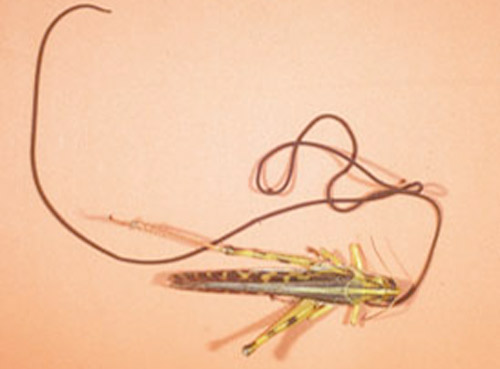common names: horsehair worms, hairworms, Gordian worms, nematomorphs
scientific name: Gordius spp. (Nematomorpha: Gordioidea)
Distribution - Description and Life Cycle - Importance - Selected References
Distribution (Back to Top)
This relatively small group of large worms is found throughout world, but usually is restricted to areas near water. About 11 species occur in the United States. They are commonly confused with mermithid nematodes. Poinar (1991) provides a key to genera found in North America. Baker and Capinera (1997) provide a summary with emphasis on nematomorphs affecting grasshoppers.
Description and Life Cycle (Back to Top)
The life cycle of nematomorphs has 4 stages: (1) the egg, (2) the pre-parasitic larva, which hatches from the egg, (3) the parasitic larva that lives and grows within an invertebrate (usually insect) host, and (4) the free-living aquatic adult. The worms complete nearly all their development within the insect host, but usually this is never seen. It is only when the adults leave their host, which normally occurs in water, that they are detected.
The preparasitic worms are minute, and infect their host when they are accidentally ingested. They cannot penetrate hosts from the outside. Nematomorphs infect insects, including crickets, cockroaches, beetles, mantids, and grasshoppers, but also spiders and woodlice (sowbugs). The feeding by the nematomorphs is at the expense of the host, of course, and infection disrupts the growth of immature insects and the reproduction of mature insects. Infected insects also tend to die prematurely.
The species most commonly encountered, and perhaps the best studied species, is Gordius robustus. It occasionally attains high densities in its tettigoniid host Anabrus simplex Haldeman, also known as the Mormon cricket. The following information is based on Gordius robustus.
Egg: The minute, ovate eggs are only about 40 microns wide and 50 microns long. They are deposited in water, in slender strips held together with gelatinous material. The number of eggs produced per female is enormous; Thorne (1940) estimated 27 million eggs from a single female. The eggs are deposited in the spring after the adults move from their overwintering sites in soil, under rocks, and in organic debris. Shallow water, including swamps, pools and streams, are acceptable oviposition sites.
Larvae: Apparently larvae swim about freely in the water after hatching, and are ingested with water when insects drink. Once inside a host insect, the larvae penetrate the insect's gut and enter its body cavity. However, more recent research (Hanelt and Janovy 1999) suggests that the larvae enter intermediate hosts and encyst, and infection of the final insect host may require consumption of these cysts. Further, these authors speculate that aquatic insects may be the intermediate hosts. In any event, eventually the larvae mature and escape from the host, normally in two to three months. Thorne (1940) suggests that emergence from the adult occurs only in the presence of water, though the mechanism for detection of water is unknown. Thomas et al. (2002) showed that infected hosts are more likely to enter water than non-infected hosts, reinforcing the idea that water is required for emergence.
Adults: These worms resemble nematodes, but are very long, usually 30 to 40 cm but sometimes 120 cm in length, and quite narrow in diameter, often only 1 mm. The adults are featureless, with a blunt head and slightly swollen tail. The color is usually mauve-brown to black. The sexes are separate.

Figure 1. Adult of horsehair worm (nematomorph), Gordius sp. Photograph by Sharon LaPlante.
Figure 2. Horsehair worm, Gordius sp, that emerged from grasshopper. Photograph by John Capinera, University of Florida.
Figure 3. Horsehair worm, Gordius sp, that emerged from Florida woods roach. Photograph by Lyle J. Buss, University of Florida.
Importance (Back to Top)
The impact of horsehair worms is highly variable, but usually slight. Because insects must drink from free water in order to be infected, few seem to acquire these parasites. Also, they must be long-lived in order for the worms to complete their development. However, Thorne (1940) reported an infection level of 99% at one site, so the potential effect is great. Insects infected by nematomorphs rarely produce eggs. Even a single worm is large relative to its hosts, so sexual development is eliminated. Horsehair worms are mostly a curiosity and come to people's attention because of their large size and sinister appearance. Their common name, horsehair worm, is derived both from their long thin appearance and the fact that they sometimes occur in livestock watering tanks, where they emerge from drowned grasshoppers that carelessly landed upon water.
Click here for a video of a horsehair worm and its spider host.
Click here for a video of a horsehair worm and its earwig host.
Selected References (Back to Top)
- Baker GL, Capinera JL. 1997. Nematodes and nematomorphs as control agents of grasshoppers and locusts. Memoirs of the Entomological Society of Canada. 171: 157-211.
- Hanelt B, Janovy Jr, J. 1999. The life cycle of a horsehair worm, Gordius robustus (Nematomorpha: Gordioidea). Journal of Parasitology 85: 139-141.
- Hanelt B, Thomas F, Schmidt-Rhaesa. 2005. Biology of the phylum Nematomorpha. Advances in Parasitology 59: 243-305.
- Poinar GO Jr. 1991. Nematoda and Nematomorpha Pages 249-283. In Thorp JH, Covich AP (eds.). Ecology and Classification of North American Freshwater Invertebrates. Academic Press, San Diego, CA
- Thorne G. 1940. The hairworm, Gordius robustus Leidy, as a parasite of the Mormon cricket, Anabrus simplex Haldeman. Journal of the Washington Academy of Science 30: 219-231.
- Thomas F, Schmidt-Rhaesa A, Martin G, Manu C, Durand P, Renaud F. 2002. Do hairworms (Nematomorpha) manipulate the water seeking behavior of their terrestrial hosts? Journal of Evolutionary Biology 15: 356-361.

